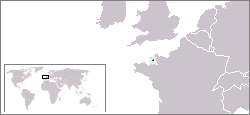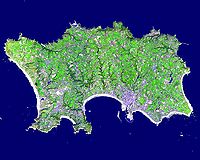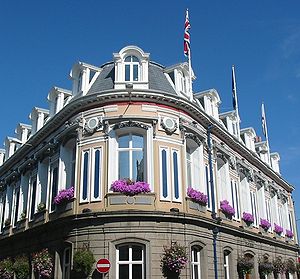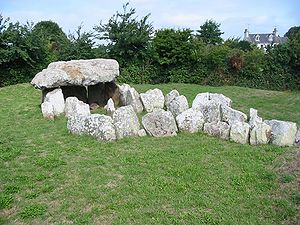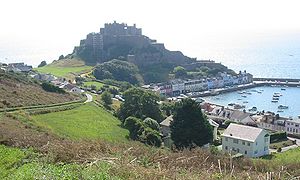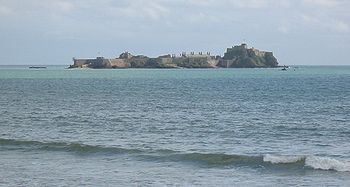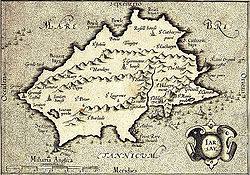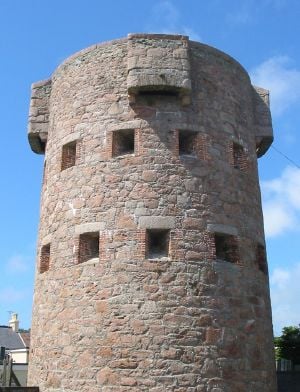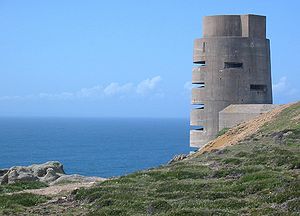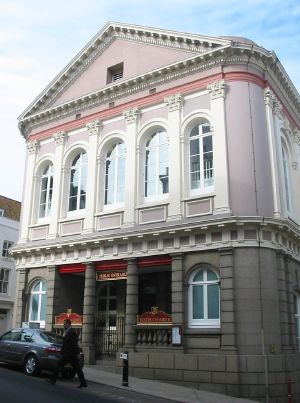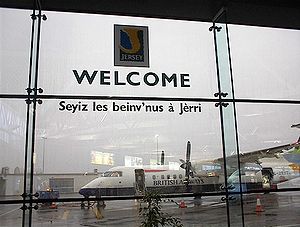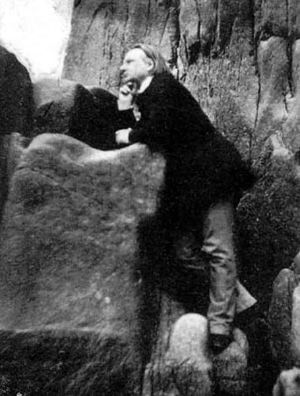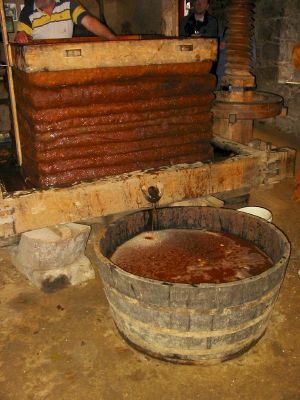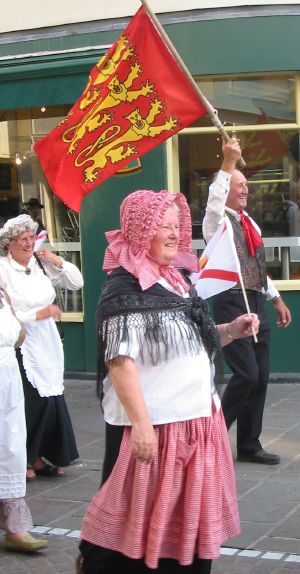Jersey
| Bailiwick of Jersey Bailliage de Jersey | |||||
| |||||
| Anthem: "God Save the Queen" (official) "Ma Normandie" ("My Normandy") (official for occasions when distinguishing anthem required) | |||||
| Capital | Saint Helier 49°11.401′N 2°06.600′W | ||||
|---|---|---|---|---|---|
| Largest city | capital | ||||
| Official languages | English, French | ||||
| Government | |||||
| - Chief of state | Elizabeth II, Duchess of Normandy | ||||
| - Lt. Governor | Lt. Gen. Andrew Ridgway | ||||
| - Bailiff | Sir Philip Bailhache | ||||
| - Chief Minister | Senator Frank Walker | ||||
| Status | British crown dependency | ||||
| - Separation from mainland Normandy | 1204 | ||||
| - Liberation from German occupation | 9 May 1945 | ||||
| Area | |||||
| - Total | 116 km² (219th) 45 sq mi | ||||
| - Water (%) | 0 | ||||
| Population | |||||
| - Dec 2005 estimate | 88,2001 | ||||
| - 2001 census | 87,186 | ||||
| - Density | 760/km² 2,018/sq mi | ||||
| GDP (PPP) | 2003 estimate | ||||
| - Total | £3.6 billion | ||||
| - Per capita | £40,000 (2003 estimate) | ||||
| HDI (n/a) | n/a (n/a) | ||||
| Currency | Pound sterling3 (GBP)
| ||||
| Time zone | GMT (UTC) | ||||
| - Summer (DST) | (UTC+1) | ||||
| Internet TLD | .je | ||||
| Calling code | +44 | ||||
The Bailiwick of Jersey (Jèrriais: Jèrri) is a British Crown dependency off the coast of Normandy, France. As well as the island of Jersey itself, the Bailiwick includes the uninhabited islands of the Minquiers, Écréhous, the Pierres de Lecq and other rocks and reefs. Together with the Bailiwick of Guernsey it forms the grouping known as the Channel Islands.
The defence of all these islands is the responsibility of the United Kingdom. However, Jersey is not part of the UK, nor the European Union, but is rather a separate possession of the Crown, comparable to the Isle of Man. Jersey belongs to the Common Travel Area.
Jersey and the other Channel Islands represent the last remnants of the medieval Dukedom of Normandy that held sway in both France and England. These islands were the only British soil occupied by German troops in World War II.
Geography
Jersey is an island measuring 46 square miles (118.2 square kilometers), including reclaimed land and intertidal zone, which is about 0.7 times the size of Washington, DCin the United States.
It is located in the English Channel, approximately 12 nautical miles (22 kilometers from the Cotentin Peninsula in Normandy, France, and approximately 100 miles (140 kilometers) south of Great Britain. As of October 15 2006, the States of Jersey It is the largest and southernmost of the Channel Islands.
The island is a plateau mantled with loess. It has generally low-lying terrain on south coast, with some rocky headlands, rising gradually to rugged picturesque cliffs along north coast. Coasts are reef-strewn, and a breakwater in St Aubin's Bay protects St Helier harbour. There are sand dunes along west coast, and small valleys running north-south intersect the island. Very large tidal variation exposes large expanses of sand and rock to southeast at low tide. The highest point is Les Platons at 470 feet (143 meters).
The climate is temperate with mild winters and cool summers, and the mean annual temperature is 52°F (11°C). Frost is rare. It also averages the most sunshine per year in the British Isles. The terrain consists of a plateau sloping from long sandy bays in the south to rugged cliffs in the north. The plateau is cut by valleys running generally north-south.
Gorse is one of Jersey's commonest large plants, the flowers of which create the blaze of gold on headlands and heaths in late spring and early summer. Gorse is often accompanied by dodder, a parasitic plant which draws sustenance from the gorse plant's spiky foliage.
Jersey has a population of reptiles and amphibians. Among the latter is the common toad, Bufo bufo, a creature whose French name, crapaud, has been adopted as an affectionate nickname for all Jerseymen. Jersey's frogs, far from being common, are the agile variety, which is found nowhere else in Britain.
There is the green lizard, the wall lizard, the Jersey tiger moth, and the white-toothed shrew, as well as the herring gull, the stiff-winged fulmars, jet-black, green-eyed shags, larger-than-life black-backed gulls and clown-faced puffins. Offshore, there are herons, egrets, terns, curlews and even kingfishers to the list.
No natural hazards have been reported, although there are issues with waste disposal, air pollution and traffic.
Three areas of land are protected for their ecological or geological interest as sites of Special Interest (SSI): Les Landes, Les Blanches Banques and La Lande du Ouest]. A large area of intertidal zone is designated as a Ramsar site. Jersey is the home of Durrell Wildlife (formerly known as the Jersey Zoological Park) founded by the naturalist, zookeeper, and author Gerald Durrell.
Saint Helier, one of the 12 parishes and the largest town in Jersey, has a population of about 28,000, and is the capital of the Island (although Government House is situated in St. Saviour). The parish covers a surface area of 4.1 square miles, being 9 percent of the total land area of the Island (this includes reclaimed land area of 494 acres). About 30 percent of the population concentrated in Saint Helier
History
Jersey history is influenced by its strategic location between the northern coast of France and the southern coast of England; the island's recorded history extends over a thousand years.
Prehistory
Jersey has been an island for approximately 8000 years. The earliest evidence of human activity dates to about 250,000 years ago when bands of hunters used the caves at La Cotte de St Brelade as a base for hunting mammoth. There was sporadic activity in the area by nomadic bands of hunters until the introduction of settled communities in the Neolithic period, which is marked by the building of the ritual burial sites known as dolmens. Archaeological evidence shows that there were trading links with Brittany and the south coast of England during this time.
Roman influence
Evidence of bronze-age and early iron-age settlements can be found in many locations around the island. While archaeological evidence of Roman influence has been found, in particular the coastal headland site at Le Pinacle, Les Landes, where remains of a primitive structure are attributed to Roman temple worship (fanum), evidence for regular Roman occupation has yet to be established.
Christianity
The Channel Islands, then called the Lenur Islands, were occupied by the Britons during their migration to Brittany (fifth-sixth century). Various saints such as the Celts Samson of Dol and Branwaldr (Brelade) were active in the region, although tradition has it that it was Saint Helier from Tongeren in modern-day Belgium who first brought Christianity to the Island in the sixth century, and Charlemagne sent his emissary to the island (at that time called Angia, also spelt Agna)
Normans
The name for Jersey itself is sourced to Viking activity in the area between the ninth and renth centuries: the Norse suffix -ey for island can be found in many places around the northern European coasts. The Channel Islands remained politically linked to Brittany until 933 when William Longsword, Duke of Normandy seized the Cotentin and the islands and added them to his domain; in 1066 Duke William II of Normandy defeated Harold at Hastings to become king of England; however, he continued to rule his French possessions as a separate entity.
The Dukes of Normandy owned considerable estates on the island, and Norman families living on their estates founded many of the historical Norman-French Jersey family names. King John lost all his territories in mainland Normandy in 1204 to King Philip II Augustus, but retained possession of Jersey, along with Guernsey and the other Channel Islands; the islands have been internally self-governing since
The Feudal Age
From 1204 onwards the Channel Islands ceased to be a peaceful backwater and were thrown into the spotlight as a potential flashpoint on the international stage between England and France. Separation from Normandy made reorganization necessary. Jersey kept its Norman law and local customs but was administered for the king by a warden or a lord.
In the Treaty of Paris (1253) the King of France gave up claim to the Channel Islands. The claim was based upon his position as feudal overlord of the Duke of Normandy. The King of England gave up claim to mainland Normandy and appointed a Warden, a position now termed Lieutenant-Governor and a Bailiff to govern in his stead. The Channel Islands were never formerly absorbed into the Kingdom of England, however.
Mont Orgueil castle was built at this time to serve as a Royal fortress and military base. During the Hundred Years' War the island was attacked many times, including twice in the 1338-1339 Channel campaign, and was even occupied for a couple of years in the 1380s. Because of the island's strategic importance to the English Crown the islanders were able to negotiate a number of benefits for themselves. During the Wars of the Roses the island was occupied by the French for seven years (1461-68) before Sir Richard Harliston arrived in the island to claim it back for the English king. By the end of the fifteenth century, Jersey had its own captain, later called governor
Protestantism adopted
During the sixteenth century, the islanders adopted the Protestant religion and life became very austere. The increasing use of gunpowder on the battlefield meant that the fortifications on the island had to be adapted and a new fortress built to defend St Aubin's Bay. The new Elizabeth Castle was named after the queen by Sir Walter Raleigh when he was governor. The island militia was reorganised on a parish basis and each parish had two cannon which were usually housed in the church - one of the St Peter cannon can still be seen at the bottom of Beaumont Hill.
The production of knitwear reached such a scale that it threatened the island's ability to produce its own food and so laws were passed regulating who could knit with whom and when. The islanders also became involved with the Newfoundland fisheries at this time. The boats left the island in February/March following a church service in St Brelade's church and they wouldn't return again until September/October. During the 1640s England was split by Civil War and hostilities spread into Scotland and Ireland as well. Jersey was divided and while the sympathy of islanders lay with Parliament the de Carterets held the island for the king.
The De Carterets, seigneurs of St Ouen, held the island for the king from 1643 to 1651. The future Charles II visited the island in 1646 and again in 1649 following the execution of his father. It was in the Royal Square in St. Helier on February 17, 1649, that Charles was first publicly proclaimed king after his father's death. Parliamentarian forces eventually captured the island in 1651. In recognition for all the help given to him during his exile, Charles II gave George Carteret, Bailiff and governor, a large grant of land in the American colonies, which he promptly named New Jersey, now part of the United States of America.
Towards the end of the seventeenth century Jersey strengthened its links with the Americas when many islanders emigrated to New England and north east Canada. The Jersey merchants built up a thriving business empire in the Newfoundland and Gaspé fisheries. Companies such as Robins and the Le Boutilliers set up thriving businesses.
Feuds, prosperity
Feuds between the Magots and Charlots, Laurels vand Roses, tore the island in the eighteenth and nineteenth centuries, but it also prospered from the Newfoundland fisheries, privateering, and smuggling, and, later, from cattle, potatoes, and the tourist trade. The Code of 1771 laid down for the first time the extant laws of Jersey, and from this time the sole legislative power was vested in the States.
Methodism arrives
Methodism arrived in Jersey in 1774, brought by fishermen returning from Newfoundland. Conflict with the authorities ensued when men refused to attend militia drill when that coincided with chapel meetings. The Royal Court attempted to proscribe Methodist meetings, but King George III refused to countenance such interference with liberty of religion. The first Methodist minister in Jersey was appointed in 1783, and John Wesley preached in Jersey in August 1789, his words being interpreted into the vernacular for the benefit of those from the country parishes. The first building constructed specifically for Methodist worship was erected in St Ouen in 1809.
Invasions attempted
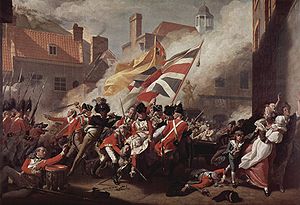
The eighteenth century was a period of political tension between Britain and France as the two nations clashed all over the world as their ambitions grew. Because of its position Jersey was more or less on a continuous war footing.
During the American Wars of Independence there were two attempted invasions of the island. In 1779 the Prince of Orange William V was prevented from landing at St Ouen's Bay; on January 6, 1781, a force lead by Baron de Rullecourt captured St Helier in a daring dawn raid, but was defeated by a British army lead by Major Peirson. A short lived peace was followed by the French Revolutionary Wars and the Napoleonic Wars which, when they had ended, had changed Jersey for ever. In 1799-1800, over 6000 Russian troops were quartered in Jersey after an evacuation of Holland.
Economy grows
The military roads constructed (on occasion at gunpoint) by the Governor, General George Don, to link coastal fortifications with S. Helier harbour had an unexpected effect on agriculture once peace restored reliable trade links. Farmers in previously isolated valleys were able to swiftly transport crops grown in the island's microclimate to waiting ships, and then on to the markets of London and Paris ahead of the competition.
The number of English speaking soldiers stationed in the island and the number of retired officers and English speaking labourers who came to the islands in the 1820s meant the island gradually moved towards an English-speaking culture.
Jersey became one of the largest wooden ship-building areas in the British Isles, building over 900 vessels around the island. In the late nineteenth century, as the former thriving cider and wool industries declined, island farmers benefited from the development of two luxury products - the Jersey cow and the Jersey Royal potato. The former was the product of careful and selective breeding programmes; the latter being a total fluke.
The nineteenth century brought the rise of tourism as an important industry, which reached its climax in the period from the end of the Second World War to the 1980s.
World War I
English was first permitted in debates in the States of Jersey in 1901 and the first legislation to be drawn up primarily in English was the Income Tax Law of 1928.
Emotionally, the 20th century has been dominated by the Occupation of the island by German troops between 1940 and 1945[1] which saw about 8,000 islanders evacuated, 1,200 islanders deported to camps in Germany and over 300 islanders being sentenced to the prison and concentration camps of mainland Europe (it depended on Neuengamme). 20 died as a result. The islanders endured near-starvation in the winter of 1944-45, after it had been cut off from German-occupied Europe by Allied forces advancing from the Normandy beachheads, avoided only by the arrival of the Red Cross supply ship Vega in December 1944. Liberation Day - May 9 is marked as a public holiday. The Channel Islands were the only British soil occupied by German troops in World War II.
The event which has had the most far reaching effect on Jersey in modern times, is the growth of the finance industry in the island from the 1960s onwards.
xxx
Trade laid the foundations of prosperity, aided by neutrality between England and France.[2] The Jersey way of life involved agriculture, fishing, shipbuilding, and production of woollen goods until nineteenth-century improvements in transport links brought tourism to the Island.
Jersey was occupied by Germany from 1 July, 1940, and was held until 9 May, 1945.[3]
Politics
Jersey's legislature is the States of Jersey. It includes fifty-three elected members: twelve senators (elected for six-year terms), twelve constables (heads of parishes elected for three-year terms), twenty-nine deputies (elected for three-year terms); the Bailiff and the Deputy Bailiff (appointed to preside over the assembly and having a casting vote in favour of the status quo when presiding); and three non-voting members (the Dean of Jersey, the Attorney General, and the Solicitor General) appointed by the Crown. Government departments are run by a cabinet of ministers under a Chief Minister. The civil head of the Island is the Bailiff.
All current States Members have been elected as independents. Formally constituted political parties are unfashionable, although groups of "like-minded members" act in concert.
The Jersey Democratic Alliance is the only party currently having States Members, although these were elected as independents. The Centre Party (Jersey) has committed to only proposing candidates for Senatorial elections, though members are free to, and have, stood for Deputy as independents. They would remain independent in the Chamber. Stuart Syvret is often reported to be of the Jersey Green Party.[4]
The legal system is based on Norman customary law (including the Clameur de Haro), statute and English law; justice is administered by the Royal Court.
Elizabeth II's traditional title as head of state is that of Duke of Normandy, but she does not hold that title formally. She reigns by her position as Queen over a crown dependency. Her representative in the island is the Lieutenant Governor, who has but a token involvement in island politics. Since 2006, the incumbent Lieutenant Governor has been Lieutenant General Andrew Ridgway.
Parishes
Administratively, Jersey is divided into twelve parishes. All have access to the sea and are named after the saints to whom their ancient parish churches are dedicated:
- Grouville (historically Saint Martin de Grouville; incorporating Les Minquiers)
- Saint Brélade
- Saint Clement
- Saint Helier
- Saint John
- Saint Lawrence
- Saint Martin (historically Saint Martin le Vieux; incorporating Les Écréhous)
- Saint Mary
- Saint Ouen
- Saint Peter
- Saint Saviour
- Trinity
The parishes of Jersey are further divided into vingtaines (or, in St. Ouen, cueillettes), divisions which are historic and nowadays mostly used for purposes of local administration and electoral constituency.
The Constable (Connétable) is the head of each parish, elected at a public election for a three year term to run the parish and to represent the municipality in the States. The Procureur du Bien Public (two in each parish) is the legal and financial representative of the parish, (elected at a public election since 2003 in accordance with the Public Elections (Amendment) (Jersey) Law 2003; formerly an Assembly of Electors of each parish elected the Procureurs in accordance with the Loi (1804) au sujet des assemblées paroissiales). A Procureur du Bien Public is elected for a mandate of three years as a public trustee for the funds and property of the parish and to be empowered to pass contract on behalf of the parish if so authorised by a Parish Assembly.
Centeniers are elected at a public election within each parish for a term of three years to undertake policing within the parish. The Centenier is the only officer authorised to charge and bail offenders. Formerly, the senior Centenier of each parish (known as the Chef de Police) deputised for the Constable in the States of Jersey when the Constable was unable to attend a sitting of the States. This function has now been abolished.
International relations
Although diplomatic representation is reserved to the Crown, Jersey negotiates directly with foreign governments on matters within the competence of the States of Jersey. Jersey maintains a permanent non-diplomatic representation in Caen, the Bureau de Jersey, and a branch office in Rennes. A similar office, the Maison de Normandie, in St. Helier represents the Conseil général of Manche and the Conseil régional of Basse-Normandie and hosts the Consulate of France.
Jersey is a member of the British-Irish Council, the Commonwealth Parliamentary Association and the Assemblée parlementaire de la Francophonie. Jersey is aiming to become a full member of the Commonwealth in its own right.[5]
Dicey and Morris (p26)[6] list the separate States comprising the British Islands: "England, Scotland, Northern Ireland, the Isle of Man, Jersey, Guernsey, Alderney, [Hern] and Sark. . . is a separate country in the sense of the conflict of laws, though not one of them is a State known to public international law."
In 2007, the Chief Minister and the UK Lord Chancellor signed an agreement[7] which established a framework for the development of the international identity of Jersey. The agreement stated that:
- the UK has no democratic accountability in and for Jersey;
- the UK will not act internationally on behalf of Jersey without prior consultation;
- Jersey has an international identity which is different from that of the UK;
- the UK recognises that the interests of Jersey may differ from those of the UK, and the UK will seek to represent any differing interests when acting in an international capacity;
- the UK and Jersey will work together to resolve or clarify any differences which may arise between their respective interests.
In a survey of 700 people carried out by Channel Television in the summer of 2000, 68% supported independence from the United Kingdom.[8] Senator (now Deputy) Paul le Claire lodged a projet calling for Jersey's independence shortly thereafter. Subsequently, the Jersey Law Review published an editorial[9] and articles touching on the possibility of full independence.[10] In 2007 the Chief Minister was reported[11] as saying that Jersey had contingency plans in case independence were to be forced upon the Island or if Jersey wanted to move towards independence at a later date.
On 20 June 2007, Jersey signed an agreement[12] regarding the exchange of information relating to tax matters. This was reported[13] as the bailiwick's first tax treaty with a European state as a state in its own right (and the second after a similar agreement with the United States in 2002).
The Federal Court of Justice of Germany ruled on 1 July 2002 (case: II ZR 380/00), that under German law, for the purposes of § 110 of the German Civil Procedures Act (ZPO), Jersey is to be deemed to be part of the United Kingdom and of the European Union as well. The European Union classes Jersey as a "special territory". It is part of the Common Customs Territory.
Economy
Thanks to specialisation in a few high return sectors, at purchasing power parity Jersey has very high economic output per capita, substantially ahead of all of the world's large developed economies. The CIA World Factbook estimate of Jersey's GDP per capita for 2005 is US$57,000, which was beaten only by two other small states with similar economic characteristics, Bermuda and Luxembourg. Jersey's economy is based on financial services, tourism, electronic commerce and agriculture; financial services contribute approximately sixty percent of the Island's economy,[14] and the Island is recognised as one of the leading offshore financial centres.
In June 2005 the States introduced the Competition (Jersey) Law 2005 [15] in order to regulate competition and stimulate economic growth. This competition law was based on that of other jurisdictions.
Major agricultural products are potatoes and dairy produce. The source of milk is Jersey cattle, a small breed of cow that has also been acknowledged (though not widely so) for the quality of its meat.[16][17] Small-scale organic beef production has been reintroduced in an effort to diversify the industry.
Farmers and growers often sell surplus food and flowers in boxes on the roadside, relying on the honesty of those who pass to drop the correct change into the money box and take what they want.
On February 18 2005, Jersey was granted Fairtrade Island status.[18]
The absence of VAT has led to the recent growth of the "fulfilment" industry, whereby low-value luxury items, such as videos, lingerie and contact lenses are exported to the UK, avoiding VAT on arrival and thus undercutting UK prices on the same products. In 2005, the States of Jersey announced limits on licences granted to non-resident companies trading in this way.
Duty-free goods are available for purchase on travel to and from the Island.
Aside from its banking and finance underpinnings Jersey also depends on tourism. Notable hotels include:
- the Pomme d'Or overlooking Liberation Square in St. Helier, which during the occupation served as the German Navy Headquarters[19] and from whose balcony the Liberation force raised the Union Flag on Liberation Day, 9 May 1945;
- the Hotel de France, formerly the Imperial and the Jesuit college, in St. Saviour overlooking the town of St. Helier;
- the Hotel L'Horizon in St. Brelade's Bay.
- La Grande Vere, in St. Helier overlooking St. Aubins Bay, with views of Elizabeth Castle and the Waterfront.
Taxation
Until the twentieth century, the States relied on indirect taxation to finance the administration of Jersey. The levying of impôts (duties) was in the hands of the Assembly of Governor, Bailiff and Jurats until 1921 when that body's tax raising powers were transferred to the Assembly of the States, leaving the Assembly of Governor, Bailiff and Jurats to serve simply as licensing bench for the sale of alcohol (this fiscal reform also stripped the Lieutenant-Governor of most of his effective remaining administrative functions). The Income Tax Law of 1928 introducing income tax was the first law drafted entirely in English. Income tax has been levied at a flat rate of 20% for decades.
As VAT has not been levied in the Island, luxury goods have often been cheaper than in the UK or in France, providing an incentive for tourism from neighbouring countries.
On 13 May 2005, the States of Jersey approved the introduction of a goods and services tax, scheduled for 2008.[20]
Currency
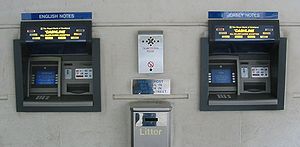
Jersey issues its own Jersey banknotes and coins which circulate with UK coinage, Bank of England notes, Scottish notes and Guernsey currency within the Island.
Coinage
Designs on the reverse of Jersey coins:
- 1p Le Hocq Tower (coastal defence)
- 2p L'Hermitage, site where Saint Helier lived
- 5p Seymour Tower (offshore defence)
- 10p La Pouquelaye de Faldouet (dolmen)
- 20p La Corbière lighthouse
- 50p Grosnez Castle (ruins)
Pound coins are issued, but are much less widely used than pound notes. Designs on the reverse of Jersey pound coins include historic ships built in Jersey and a series of the twelve parishes' crests. The motto round the milled edge of Jersey pound coins is Insula Caesarea (Latin: "Island of Jersey"). Two pound coins are issued also, but in very small quantities.
Demographics
Population
The Island is host to large number of people born outside Jersey; 47% of the population are not originally from the island.[21] Thirty percent of the population is concentrated in Saint Helier, the island's only town.
Jersey has an aging population. The main reason for this change particular to Jersey is the emigration of young people seeking opportunities the Island cannot provide.
For immigration and nationality purposes the United Kingdom generally treats Jersey as though it were part of the UK. However, Jersey is constitutionally entitled to restrict immigration by non-Jersey residents and maintains its own immigration and border controls. Population is currently controlled by restrictions on those without residential status purchasing or renting property in the Island. Although Jersey citizens are full British citizens, an endorsement restricting the right of establishment in European Union states other than the UK is placed in the Jersey passport of British citizens connected solely with the Channel Islands and Isle of Man. Those who have a parent or grandparent born in the United Kingdom, or who have lived in the United Kingdom for five years, are not subject to this restriction.
Censuses have been undertaken in Jersey since 1821, the most recent being the 2001 Census on March 11.
Ethnicity
Of the roughly 88,000 people in Jersey, around two-fifths are of Jersey/Norman descent and two-fifths of British (English, Scottish, Welsh and Northern Irish) descent. The largest minority groups in the island, after the British, are Portuguese (around 7%, especially Madeiran), Irish and Polish. The French community is also always present. The people of Jersey are often called Islanders, or in individual terms Jerseyman or Jerseywoman. Most Jersey-born people consider themselves British and value the special relationship between the British Crown and the Island.
Religion
Religion in Jersey has a complex history and much diversity. The established church is the Church of England. In the countryside, Methodism found its traditional stronghold. A minority of Roman Catholics can also be found in Jersey, with two Catholic private schools (De La Salle College in Saint Saviour being an all-boys Catholic school, and Beaulieu Convent School down the road in Saint Helier being an all-girls school where the sisters still have a presence in school life).
Religion
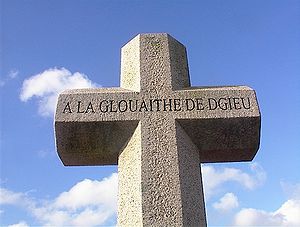
The island's patron saint is Saint Helier.
The established church is the Church of England, but Methodism has been historically strong, especially in country areas, and remains influential. A large minority of the population is Roman Catholic. The historic toleration of religious minorities has led to many persecuted minorities seeking refuge in Jersey. This has left a rich legacy of churches, chapels and places of worship.
Language
Until the nineteenth century, indigenous Jèrriais — a variety of Norman French — was the language of the island, though French was used for official business. Since 1900, English has been permitted in debates in the States of Jersey and has come to dominate. During the twentieth century, however, an intense language shift took place and Jersey today is predominantly English-speaking. Jèrriais nonetheless survives; around 2,600 islanders (three per cent) are reckoned to be habitual speakers, and some 10,000 (12 percent) in all claim some knowledge of the language, particularly amongst the elderly in rural parishes. There have been efforts to revive Jèrriais in schools, and the highest number of declared Jèrriais speakers is in the capital.
The dialects of Jèrriais differ in phonology and, to a lesser extent, lexis between parishes, with the most marked differences to be heard between those of the west and east. Many place names are in Jèrriais, and French and English place names are also to be found. Anglicisation of the toponymy increased apace with the migration of English people to the island. The characteristic accent of Jersey English is rapidly being lost due to the influence of media and education.
Men and women
Marriage and the family
Education
Class
Culture
The culture of Jersey is the culture of the Bailiwick of Jersey. This has been shaped by Jersey's indigenous Norman language and traditions as well as French and British cultural influences, to which have been added cultural trends from immigrant communities such as the Bretons and the Portuguese.
Architecture
Art
Some Neolithic carvings are the earliest works of artistic character to be found in Jersey. Only fragmentary wall-paintings remain from the rich mediaeval artistic heritage, after the wholesale iconoclasm of the Calvinist reformation of the sixteenth century.

Some Neolithic carvings are the earliest works of artistic character to be found in Jersey. Only fragmentary wall-paintings remain from the rich mediaeval artistic heritage, after the wholesale iconoclasm of the Calvinist reformation of the 16th century - the most notable of these are the wall-paintings of the Fisherman's Chapel (la Chapelle ès Pêcheurs) in St. Brelade.
The 1751 statue of George II by John Cheere in the Royal Square was Jersey's first public sculpture since the Reformation. Subsequent works of public art to be seen include:
- Westaway monument (1875, Pierre-Alfred Robinet)
- Don monument (1885, Pierre-Alfred Robinet)
- Queen Victoria statue (1890, Georges Wallet)
- George V statue (1939, William Reid Dick)
- Liberation sculpture (1995, Philip Jackson)
- La Vaque dé Jèrri (2001, John McKenna)
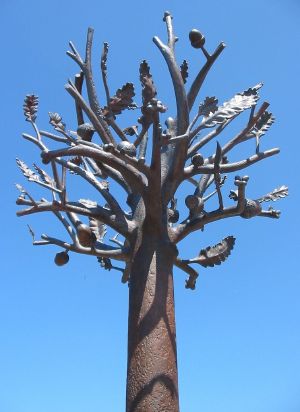
John Singleton Copley's painting of the Battle of Jersey (6th January, 1781), "The Death of Major Pierson", became a national icon. The States of Jersey failed in an attempt to purchase it (it is now in the Tate Britain), but the image is reproduced on the reverse of a Jersey £10 note.
John Le Capelain (1812-1848) was the son of Samuel Le Capelain, a printer and lithographer, and Elizabeth Anne Pinckney, his English wife. Le Capelain displayed early talent, but never had formal art training. He was born and lived all his life in St. Helier, setting up his studio in the attic of his parents' house in Hill Street. He is best known for his watercolours, although he had earlier followed his father in lithography but abandoned it after 1843. He travelled widely, taking advantage of St. Helier's excellent maritime links, and went sketching in France, England and Scotland. He was commissioned to produce a series of watercolours which were presented to Queen Victoria by the States of Jersey to commemorate her visit of 1846. The series was subsequently lithographed and published in book form. The Queen commissioned Le Capelain to produce a series of watercolour views of the Isle of Wight and it was while working on this commission that Le Capelain contracted tuberculosis and died, barely a week after his 36th birthday. A collection of his works, presented by public subscription in his memory, is displayed in the Parish Hall of St. Helier.
Among artists attracted to Jersey in the 19th century was Sarah Louisa Kilpack (1839-1909), an English artist noted for seascapes and coastal scenes, often stormy, produced for exhibition in London.
John Everett Millais, a Jèrriais speaker from a Jersey family, was born in England, but is considered a Jersey artist.
The "Glass Church" (St. Matthew's, Millbrook, St. Lawrence) is decorated with Art Deco glass by René Lalique, commissioned by Florence, Lady Trent, the Jersey-born wife of Lord Trent, founder of Boots Chemists.
Edmund Blampied (1886-1966), illustrator and artist, is the most popular Jersey artist of the 20th century.
Hector Whistler, educated at Victoria College, produced some decorative work for the extension of the States Building.
John St. Helier Lander (1869-1944), born in St. Helier, later became a fashionable portrait painter in London. His portrait of George V hangs at Victoria College, and the Masonic Temple in St. Helier holds a number of masonic portraits by him.
Philip John Ouless (1817-1885), a successful workmanlike painter of marine subjects, was the father of Walter William Ouless RA (1848-1933), who developed a career as a portrait painter in London, becoming an Associate of the Royal Academy (ARA) in 1877 and RA in 1881.
Henry Bosdet (1857-1934), an artist in stained glass in a Pre-Raphaelite style, taught in the Royal Academy schools in London. Some of his work can be seen in his native Island.
Suzanne Malherbe and Claude Cahun, the "Surrealist Sisters" were among photographers attracted to Jersey.
Sir Francis Cook (1907-1978), English painter, moved to Jersey in 1948. In the 1960s he bought the former Methodist chapel at Augrès and converted it to a studio and gallery which was donated after his death to the Jersey Heritage Trust along with a collection of his works. The building, now named the Sir Francis Cook Gallery, serves as an exhibition space.
The Berni Gallery at the Jersey Arts Centre holds a programme of exhibitions by Jersey and visiting artists. The Barreau-Le Maistre Gallery in the Jersey Museum displays works from the permanent collection of the Jersey Heritage trust. Plans for a National Gallery to display the range of national holdings of visual art and provide suitable temporary exhibition space have been proposed from time to time. Despite the high profile support of Sir Philip Bailhache, Bailiff of Jersey, such plans have not made progress.
Cinema
In 1909, T.J. West established the first cinema in the Royal Hall in St. Helier, which became known as West's Cinema in 1923 (demolished 1977). The Jersey Film Society was founded on 11 December 1947 at the Café Bleu, West's Cinema. The first talking picture, The Perfect Alibi, was shown on 30 December 1929 at the Picture House in St. Helier. The large Art Deco Forum Cinema was opened in 1935 — during the German Occupation this was used for German propaganda films. The Odeon Cinema (now the New Forum) was opened 2 June 1952.
Since 1997[citation needed], Kevin Lewis (formerly of The Cine Centre and now of the New Forum) has arranged the Jersey Film Festival, a charity event showing the latest and also classic films outdoors in 35 mm on a big screen. The 2006 festival was held in Howard Davis Park, St Helier on the 12-18 August 2006. In August 2006, plans were revealed to convert the former Odeon building into a department store while retaining the landmark architecture.
Food and drink
Seafood has traditionally been important to the cuisine of Jersey: mussels (called moules locally), oysters, lobster and crabs — especially spider crabs — ormers, and conger.
Jersey milk being very rich, cream and butter have played a large part in insular cooking. (See Channel Island milk) However there is no indigenous tradition of cheese making, contrary to the custom of mainland Normandy, but some cheese is produced commercially. Jersey fudge, mostly imported and made with milk from overseas Jersey cattle herds, is a popular food product with tourists.
Jersey Royal potatoes are the local variety of new potato, and the island is famous for its early crop of small potatoes from the south-facing côtils (steeply-sloping fields). They are eaten in a variety of ways, often simply boiled and served with butter.
Apples historically were an important crop. Bourdélots are apple dumplings, but the most typical speciality is black butter (lé nièr beurre), a dark spicy spread prepared from apples, cider and spices.
Among other traditional dishes are cabbage loaf, Jersey wonders (les mèrvelles), fliottes, bean crock (les pais au fou), nettle (ortchie) soup, vraic buns.
Cider used to be an important export. After decline and near-disappearance in the late twentieth century, apple production is being increased and promoted. Apple brandy is also produced, as is some wine.
xxxx
Food and drink
Seafood has traditionally been important to the cuisine of Jersey: mussels (called moules locally), oysters, lobster and crabs — especially spider crabs which are considered a particular delicacy. Razor-fishing, sand-eeling and limpeting used to be popular activities but have declined in importance. Ormers, being highly sought after, are conserved and fishing is restricted. Another seafood specialty is conger soup.
Bean crock (les pais au fou) can best be described as a sort of Norman cassoulet. It is a slow-cooked pork and bean stew, most authentically containing a pig's trotter. In the past the dish was so ubiquitous that English-speaking visitors, purporting to believe that the people of Jersey ate nothing else, dubbed the inhabitants Jersey beans (this epithet is sometimes considered derogatory, but a Jersey primary school French coursebook Salut Jersey featured two beans Haricot and Mangetout).
Nettle (ortchie) soup was once a popular dish and was considered a tonic for the heart.
Jersey wonders (les mèrvelles) a sort of rich twisted doughnut is made less in the home than formerly but is still a popular treat at fairs and festivals. A sort of wonder poached in milk is known as a fliotte (eune fliotte).
Cabbage loaf is the traditional Jersey bread baked between two cabbage leaves. Vraic buns are very large sweet buns with raisins, and were traditionally eaten when men went out vraicing on the shore.
Jersey milk being very rich, cream and butter have played a large part in insular cooking. Unlike other parts of the Duchy of Normandy, there is no historical tradition of cheese - Jersey people traditionally preferring rich yellow thickly-spread butter.
Jersey Royal potatoes are the local variety of new potato, and the island is famous for its early crop of small, tasty potatoes from the south-facing côtils (steeply-sloping fields). They are eaten in any variety of ways, often simply boiled and served with butter.
Apples historically were an important crop. Bourdélots are apple dumplings, but the most typical speciality is black butter (lé nièr beurre), a dark spicy spread prepared from apples, cider and spices. Annual black butter nights (séthées d'nièr beurre) in autumn are still an important traditional social occasion in country areas; the stirring must be maintained around the clock.
Cider used to be an important export. After decline and near-disappearance in the late 20th century, apple production is being increased and promoted. Apple brandy is also produced. Some wine is produced.
xxxx
Folklore and customs
Jersey people are traditionally known as crapauds (toads) due to the particular fauna of Jersey that does not exist in the other Channel Islands, especially in Guernsey. According to a Guernsey legend, St Samson of Dol arrived in Jersey but encountered such a hostile reception in the then-pagan island that he proceeded on to Guernsey. The welcome being much warmer in Guernsey, he repaid the inhabitants of that island by sending all the snakes and toads from Guernsey to Jersey.
Vraic is the Jersey word for seaweed and the collection of seaweed for fertiliser, vraicing, was an important activity in the past, but still continues on a small scale.
The Battle of Flowers is the major carnival, held annually in August. First held for the coronation of Edward VII in 1902, the carnival includes a parade of floral decorated floats. Originally, these floats were torn apart to provide floral ammunition for a battle of flowers between participants and spectators, but this aspect has long been abandoned.
Annual visites du branchage are carried out twice in Summer by Parish officials to inspect roadside verges and hedges and ensure property owners have trimmed back overhanging greenery. This custom is to prevent Jersey's narrow lanes becoming hazardous or impassable through overgrown vegetation. The action of branchage (pronounced in the Jèrriais fashion "brancage" as opposed to the French pronunciation) is the trimming of verges prior to the annual inspections. A haircut may also be jocularly referred to as a branchage.
Belief in witchcraft was formerly strong in Jersey, and survived in country areas well into the 20th century. Witches were supposed to hold their sabbats on Fridays at Rocqueberg, the Witches' Rock, in St. Clement. Folklore preserves a belief that witches' stones on old houses were resting places for witches flying to their meetings.
Literature
Literature in Jersey may be divided into literature in Jèrriais, Francophone literature, and literature in English.
The literary tradition in Jersey is traced back to Wace, the 12th-century Jersey-born poet.
William Prynne wrote poetry while imprisoned in Jersey, but little indigenous literature survives from before the 18th century.
Printing only arrived in Jersey in the 1780s, but the island supported a multitude of regular publications in French (and Jèrriais) and English throughout the 19th century, in which poetry, most usually topical and satirical, flourished.
The first printed Jèrriais appears in the first newspapers at the end of the 18th century. The earliest identified dated example of printed poetry in Jèrriais is a fragment by Matchi L'Gé (Matthew Le Geyt 1777–1849), dated 1795. The first printed anthology of Jèrriais poetry, Rimes Jersiaises, was published in 1865.
Influential writers include 'Laelius' (Sir Robert Pipon Marett 1820–1884, Bailiff of Jersey 1880–1884), 'A.A.L.G.' (Augustus Aspley Le Gros 1840–1877), and 'St.-Luorenchais' (Philippe Langlois 1817–1884).
Philippe Le Sueur Mourant (1848–1918) wrote under several pseudonyms. His greatest success was the character Bram Bilo, but he later developed the Pain family, newly moved to Saint Helier, who commented on its Anglicized society and fashionable entertainments.
'Elie' (Edwin J. Luce 1881–1918) was editor of the French-language newspaper La Nouvelle Chronique de Jersey and a poet who wrote topical poems for the newspaper. He died in the influenza pandemic of 1918. His brother, Philip W. Luce (1882–1966), also a journalist and poet, emigrated to Canada, but sent occasional writings back to Jersey.
'Caouain' (George W. De Carteret 1869–1940) maintained a weekly newspaper column purporting to be the work of an owl (cahouain) reporting on the latest election news and local gossip.
During the Occupation, little original writing was permitted to be published by the German censors. However very many older pieces of literature were re-published in the newspapers as an act of cultural self-assertion and morale-boosting.
Edward Le Brocq (1877–1964) revived the weekly column in 1946 with a letter from Ph'lip et Merrienne, supposedly a traditional old couple who would comment on the latest news or recall times past. The column continued until the author's death in 1964.
The most influential writer of Jèrriais in the 20th century was a U.S. citizen, George Francis Le Feuvre (1891–1984), whose pen-name was 'George d'la Forge'. He emigrated to North America after the First World War but for almost forty years maintained a flow of articles in Jèrriais back to Jersey for publication in newspapers.
Frank Le Maistre (1910–2002), compiler of the Jèrriais–French dictionary, maintained a literary output starting in the 1930s with newspaper articles under the pseudonym Marie la Pie, poems, magazine articles, and research into toponymy and etymology. He himself considered his masterpiece the translation of the Rubaiyat of Omar Khayyam that he undertook during the German Occupation (1940–1945).
The famous French writer Victor Hugo lived in exile in Jersey from 1852 to 1855.
Elinor Glyn and John Lemprière were Jersey-born writers. Frederick Tennyson, Jack Higgins and Gerald Durrell are among writers who have made Jersey their home.
Printing
Printing arrived in Jersey only in the 1780s, but the Island supported a multitude of regular publications in French (and Jèrriais) and English throughout the nineteenth century, in which poetry, most usually topical and satirical, flourished (see Jèrriais literature).
John Everett Millais, Elinor Glyn, and Wace are among Jersey's artistic figures. Lillie Langtry, the Jersey Lily, is the Island's most widely recognised cultural icon. The famous French writer, Victor Hugo, lived in exile in Jersey from 1852 to 1855.
The Island is particularly famous for the Battle of Flowers, a carnival held annually since 1902.[22]
The Island's patron saint is Saint Helier.[23]
Media
Jersey's only newspaper, the Jersey Evening Post, claims that it has an average issue readership of 73% of adults in Jersey and that over the course of a week 93 per cent of all adults will read a copy of the newspaper,[24] it being the main printed source of local news and official notices. The newspaper features a weekly Jèrriais column accompanied by English-language précis. BBC Radio Jersey provides a radio service and Spotlight Channel Islands provides a joint television news services with Guernsey but with headquarters in Jersey. Channel Television is a regional ITV franchise shared with the Bailiwick of Guernsey but with its headquarters in Jersey. Channel 103 is a commercial radio station.
Music
Every year in Howard Davis park Jersey hosts its annual music festivals including Rock in the Park and its newly named Avanchi presents Jazz in July.
Music and dance
The traditional folk music of Jersey was common in country areas until the mid-20th century. It cannot be separated from the musical traditions of continental Europe, and the majority of songs and tunes that have been documented have close parallels or variants, particularly in France. Most of the surviving traditional songs are in French, with a minority in Jèrriais. The majority of Jèrriais-language songs are composed pieces dating from the 19th and 20th centuries, and not of folk origin. Research conducted in the 20th century also revealed the existence of folk songs in English (eg. “The Greenland Whale Fishery”, “Died for Love”.) Only one folk song is believed to be of specifically Jersey provenance with no variants collected elsewhere: “La Chanson de Peirson”.
Very little survives of an indigenous musical or dance tradition. Written testimony from the 20th century (Frank Le Maistre; George F. Le Feuvre) points to the practice of archaic dance-forms such as the "ronde" or round dance, 18th-century dances such as the cotillon and 19th-century forms such as the polka, the schottische and the quadrille. Dances such as the "Gigoton" and "La Bébée" are both forms of polka. The violin, the chifournie (hurdy-gurdy), and later the accordion were traditional instruments for sonneurs (country dances). The decline of these dances has often been ascribed to the influence of Nonconformist Christianity that discouraged such cultural frivolities, or at least placed such a low value on these activities that they were not thought worth recording. It is more likely that, as in many other parts of Europe, they were a victim of changing fashion and a cultural shift away from traditional regional society and toward English-speaking modernity.
Among contemporary music events is Jersey Live.
Performing arts
The annual Jersey Eisteddfod provides a platform for competition in music, drama and speaking in English, French and Jèrriais.
The Opera House, opened by Lillie Langtry in 1900, and the Jersey Arts Centre are the main performance spaces, although many concerts and other cultural events take place in parish halls and other venues.
Lillie Langtry, the Jersey Lily, is the island's most widely recognised cultural icon.
Sport
Jersey participates in its own right in the Commonwealth Games, in which shooting is a strong sport. Golf is also popular - Harry Vardon was a Jerseyman.
Jersey participates in the Island Games, which it has hosted. In sporting events in which Jersey does not have international representation, when the British Home Nations are competing separately, islanders that do have high athletic skill may choose to compete for any of the Home Nations - there are, however, restrictions on subsequent transfers to represent another Home Nation.
The Muratti football match against Guernsey is one of the sporting highlights of the year. There are several rugby clubs in the island including a rugby academy for under 18s and Les Quennevais Rugby Club.
See also
|
|
|
Footnotes and references
- ↑ Bellows, Tony. What was the "Occupation" and why is "Liberation Day" celebrated in the Channel Islands?. Société Jersiaise. Retrieved 2006-10-24.
- ↑ Ommer, Rosemary E. (1991). From Outpost to Outport. McGill-Queen's University Press, p.12. ISBN 0-7735-0730-2.
- ↑ Bellows, Tony. What was the "Occupation" and why is "Liberation Day" celebrated in the Channel Islands?. Société Jersiaise. Retrieved 2006-10-15.
- ↑ Green Islands Network
- ↑ Jersey Evening Post, 23 September 2006
- ↑ *Dicey & Morris. (1993) The Conflict of Laws 12th edition. London: Sweet & Maxwell Ltd. (pp26/30) ISBN 0-420-48280-6
- ↑ Jersey and UK agree framework for developing Jersey’s international identity
- ↑ Channel Isles.
- ↑ The Sword of Damocles, Jersey Law Review, Volume 6, Issue 3, October 2002
- ↑ "Jersey and the United Kingdom: a choice of destiny", Jersey Law Review, Volume 8, Issue 3, October 2004.
- ↑ Jersey Evening Post 21 April 2007
- ↑ http://www.gov.je/ChiefMinister/International+Finance/NetherlandsandJerseysigntaxagreement.htm
- ↑ Jersey Evening Post, 22 June 2007
- ↑ Cite error: Invalid
<ref>tag; no text was provided for refs namedFactbook - ↑ http://www.jcra.je/pdf/051101%20Competition-Jersey-Law—2005.pdf
- ↑ Davenport, Philippa (2006-05-20). Jersey's cash cow. Financial Times. Retrieved 2006-10-07.
- ↑ Witmer, Jason (2004-06-11). CROPP contracts brings profitability to Ohio grass-based, organic dairies. The Rodale Institute. Retrieved 2006-10-07.
- ↑ Island achieves Fairtrade status. BBC News (2005-02-24). Retrieved 2006-10-06.
- ↑ Hassall, Peter D. (1997). Night and Fog Prisoners. Jersey Heritage Trust, p.63.
- ↑ March 8 2005 Proposition P44/2005: Fiscal Strategy
- May 12 2005
- May 13 2005 States votes
- ↑ 2001 Census
- ↑ The Jersey Battle of Flowers. Jersey Battle of Flowers Association (2005). Retrieved 2006-10-15.
- ↑ Falle, Samuel. Saint Helier — Saint Hélyi — Saint Hélier. Geraint Jennings, Société Jersiaise. Retrieved 2006-10-15.
- ↑ At the heart of Island life since 1890. Jersey Evening Post. Retrieved 2006-10-07.
- Jersey Through the Centuries, Leslie Sinel, Jersey 1984, ISBN 0-86120-003-9
External links
- States of Jersey
- Jersey Tourism
- Jersey Legal Information Board (JLIB)
- Les Pâraîsses d'Jèrri en Jèrriais (map of parishes, coat-of-arms, and history)
- BBC Jersey
- Société Jersiaise
- Jersey History
- This is Jersey (Local Portal)
- Independent visitors guide
- Jersey in The World Factbook
- Map of Jersey
Credits
New World Encyclopedia writers and editors rewrote and completed the Wikipedia article in accordance with New World Encyclopedia standards. This article abides by terms of the Creative Commons CC-by-sa 3.0 License (CC-by-sa), which may be used and disseminated with proper attribution. Credit is due under the terms of this license that can reference both the New World Encyclopedia contributors and the selfless volunteer contributors of the Wikimedia Foundation. To cite this article click here for a list of acceptable citing formats.The history of earlier contributions by wikipedians is accessible to researchers here:
The history of this article since it was imported to New World Encyclopedia:
Note: Some restrictions may apply to use of individual images which are separately licensed.


